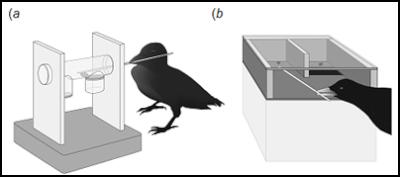Bird-brains smarter than your average ape
Bird-brains smarter than your average ape

Media
release
17 September 2008
Bird-brains smarter than your average ape
Scientists are studying whether animals look at the physical world in the same way as humans, and have discovered some birds are better at physical reasoning than apes.
Much of the apparently sophisticated animal behaviour we see in the wild is actually based on simple associations. New Caledonian crows are famous for their complex tool manufacturing abilities. What kind of cognition are these tool abilities based on? Intriguing results last year tentatively suggested that New Caledonian crows used analogical reasoning, rather than associative learning, to solve a metatool problem. In a paper appearing online this week in Proceedings of the Royal Society: B scientists at The University of Auckland present more conclusive proof that the crows’ tool skills are based on the ability to reason analogically.
In the study, New Caledonian crows were presented with a trap-tube puzzle. In this task the crows had to extract food from a horizontal tube in a direction that avoids a trap. When the crows were presented with variations of the problem where arbitrary cues were removed, the crows continued to solve the problem. This suggested the crows had not simply associatively learnt to pull away from these arbitrary cues. The scientist then presented the crows with a trap-tube with two holes. One hole was bottomless, allowing food to fall through it and out of the trap. The other hole had a base and so trapped food that was pulled into it. The crows failed to consistently solve this problem and appeared reluctant to pull the food into either hole. This suggested the crows were using the position of the hole to guide their actions.
Finally, the crows were presented with a trap-table puzzle. In this problem an animal has to choose between pulling food across a wooden table or pulling food into a hole set in the table. In a recent study 20 individuals from the great ape species were unable to transfer their knowledge from the trap-table and trap-tube or vice versa, despite the fact that both these puzzles work in the same way. Strikingly the crows in The University of Auckland study were able to solve the trap-table problem after their experience with the trap-tube. By solving the trap-table the crows demonstrated that they had not just learnt to pull away from the specific hole in the Perspex trap-tube, but could generalise what they understood to a novel problem.
“The crows appeared to solve these complex problems by identifying causal regularities,” says Professor Russell Gray of the Department of Psychology. “The crows’ success with the trap-table suggests that the crows were transferring their causal understanding to this novel problem by analogical reasoning. However, the crows didn’t understand the difference between a hole with a bottom and one without. This suggests the level of cognition here is intermediate between human-like reasoning and associative learning.”
“It was very surprising to see the crows solve the trap-table,” says PhD student Alex Taylor. “The trap table puzzle was visually different from the trap-tube in its colour, shape and material. Transfer between these two distinct problems is not predicted by theories of associative learning and is something not even the great apes have so far been able to do.”
This research was funded by a Royal Society of New Zealand Marsden Grant to Dr Gavin Hunt and Professor Russell Gray entitled, “The evolution of complex cognition: generalists or specialists”.
Wild New Caledonian tool use explained by Russell Gray http://www.youtube.com/watch?v=QNaZ3EoWnZg
Metatool
use explained by Russell Gray
http://www.youtube.com/watch?v=nIwsNvCkhrk&feature=related
The
trap-tube and trap-table experiment explained by Alex
Taylor
www.youtube.com: To be released at 00.01
(BST) Wednesday 17th
September
ENDS


 John Mazenier: Gaffer Tape And Glue Delivering New Zealand’s Mission Critical Services
John Mazenier: Gaffer Tape And Glue Delivering New Zealand’s Mission Critical Services Earthquake Commission: Ivan Skinner Award Winner Inspired By Real-life Earthquake Experience
Earthquake Commission: Ivan Skinner Award Winner Inspired By Real-life Earthquake Experience Reserve Bank: Consultation Opens On A Digital Currency For New Zealand
Reserve Bank: Consultation Opens On A Digital Currency For New Zealand NIWA: Ship Anchors May Cause Extensive And Long-lasting Damage To The Seafloor, According To New Research
NIWA: Ship Anchors May Cause Extensive And Long-lasting Damage To The Seafloor, According To New Research New Zealand Customs Service: A Step Forward For Simpler Trade Between New Zealand And Singapore
New Zealand Customs Service: A Step Forward For Simpler Trade Between New Zealand And Singapore Horizon Research: 68% Say Make Banks Offer Fraud Protection
Horizon Research: 68% Say Make Banks Offer Fraud Protection



